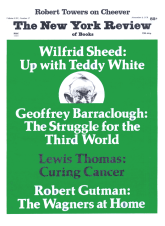In response to:
Strangers and Brothers from the June 1, 1978 issue
To the Editors:
J.H. Elliott in his review of Ronald Sanders’s Lost Tribes and Promised Lands (NYR, June 1) correctly notes the inconsistencies and incautions of Sanders’s thesis on the supposed role of the Spanish New Christians in the conquest and colonization of America.
There is one point where Professor Elliott might have shown a bit more caution himself, however. In speaking of the “terrible litmus test of acceptability” in sixteenth-century Spain—the legal test of pureza de sangre or purity of blood—Elliott observes in apparent agreement with Sanders that by this means “the doors to office, honor, and promotion were closed one by one to all except those Old Christians capable of proving that they had no taint of Jewish ancestry” (p. 34). This is to perpetuate Américo Castro’s confusion of caste and class attributions in late-feudal Spain. The distinguished social historian José Antonio Maravall has noted that the statutes of purity of blood sought to apply to New Christians on a racial/religious basis the allegation of oscura sangre or bad blood conventionally ascribed in feudal law to Spanish artisans, merchants, workers, and peasants on an occupational or property basis. To have “good blood” or honor meant then specifically that one belonged to the hereditary nobility, not that one was an old Christian. Perhaps 5 percent of the Spanish population in the sixteenth century were conversos or New Christians, but some 75 percent were non-noble and thus equally excluded from “office, honor, and promotion.” Sancho Panza, as he never tires of reminding his master, is as Old Christian as they come but also not, like Don Quijote, a noble and therefore excluded from the offices and privileges reserved for and by the aristocracy. (That is why his dream of being the Governor of an island was a comic fancy for Cervantes’s readers.) In the language of the statutes “quedan excluidos judios, moros y descendientes de villanos.” (“Jews, Moors, and descendants of the low-born are excluded [from offices of honor].”)
The achievement of Américo Castro and his followers like Ronald Sanders is that they have illuminated the presence and social action of Spain’s semitic minorities hidden in “official” Spanish nationalism. Their common defect is that they have allowed their concern with the very real problem of the New Christians to distort their vision of other social and ideological forces operating in imperial Spain in which class status and class interests are as much determinants of behavior as racial/religious ascriptions. Their version of Spanish history thus reduces to an idealist dialectic of tolerance vs. intolerance. An example of this, noted by Elliott, is Sanders’s equation of Columbus and Las Casas. Even if both figures are indeed proven to be New Christians, they cannot be yoked together under the rubric of a common New Christian “personality” tolerant and sympathetic with the fate of the oppressed native populations because of its own experience of racial exclusion and marginalization. Columbus, like many of the early Conquistadors (who came generally from the ranks of the Castillian petty aristocracy—the hidalgos and segundones or second-born), was notoriously an advocate of enslaving the American Indians, a position later developed into a “party plank” by the Tridentine proponents of Aristotle’s theory of natural slavery. Las Casas, in defending the liberty of the Indians and asking the Monarchy to grant them relief from the brutal system of forced labor imposed by the Spanish colonizers, was precisely attacking this position.
Those interested in pursuing the subject of class and caste in Spanish purity of blood doctrine may wish to consult Maravall’s essay “La función del honor en la estructura de la sociedad barroca” in a forthcoming issue of Ideologies and Literature (II, Number 8), published by the Institute for the Study of Ideologies and Literature at the University of Minnesota.
John Beverley
Associate Professor in Hispanic Studies
University of Pittsburgh
This Issue
November 9, 1978



